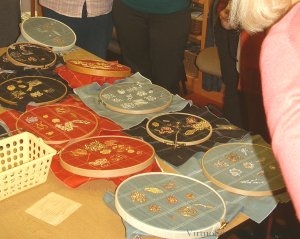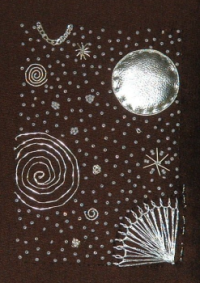Dreams of Amarna – Researching Techniques
I know that an embroidery which is “about” ancient Egypt – even if only indirectly – will have to include some gold and silver – not least, that same Crock of Gold hoard that caused so much consternation to the excavators when it was found (artefacts have a fairly limited and specialised market, while gold bars are much easier to sell, so there was some concern about security that would never have troubled the dig under ordinary circumstances).
So the next step was a trip to Durham, for a two day course in Modern Goldwork, given by Tracy Franklin. I had a fascinating time. Tracy is an excellent teacher, and it was a real treat to be able to concentrate on learning something entirely new to me. The class had the bonus that Tracy had plenty of goldwork materials available for purchase, and my local embroidery shops don’t have any. Some of what I bought for my coursework was in fact for “Dreams of Amarna” instead!
When I returned, I worked a small panel as an attempt to consolidate my grasp on the techniques and the materials. I even included some padded silver kid leather, and the background is starred with beads.
I’m quite pleased with the panel, as I managed to use almost every technique we were taught. The base fabric was a tightly woven brown synthetic, which was rather trying to work with, but I wanted something very firm for this first solo attempt at goldwork.
I will need to use very different fabrics for Amarna, and I expect that trial and error will be much employed!
You might be able to see a line of stitching, running up the edge. That’s my “signature,” in Morse code. It’s much easier to do small and neatly than letters, and sometimes I manage to hide the signature in the design.
When I am creating an embroidered piece for someone else, I try to make sure that I also provide something about the design and the making of the work. Not just care instructions, but a description of the design choices and why I made them, or if I was working to a brief, a description of the influence of the brief on my approach to the work. Given my interest in history and archaeology, it’s perhaps not surprising that the idea of providing Something For The Archive rather appeals to me.
And on that score, and on behalf of those in the future who will be interested in embroidery – please, sign your work, date it, write about it. Just think how thrilled we always are to gain an insight into the work of designers and artisans of the past!



I’m such a haphazard needlewoman (doing no needlework for years and then jumping back in with both feet) that I never thought about researching anything for a project. I like the idea, though.
As for signing work, I know that many (like me) feel our signature distracts sometimes from the art of the piece. Since my cross stitch teacher stressed the signature, I usually put my sig in a thread matching the background fabric. I don’t think I ever thought to date it though!! I don’t think I ever signed my quilts and I have never written about any of it. I do see the value of it, though, so thank you for pointing it out.
oooo, you lucky thing! A goldwork course with Tracey Franklin! And yummies to buy!
Gorgeous star panel… So dreamy and yet very life-like.
I think Something for the Archive is particularly important if a peice has some family significance. So much family (and thus social)history gets lost because one does not record things at the time. We must all have said ” If only I’d asked…”.
What a novel idea – signing in Morse code! I also agree that signing and dating work is important. There’s a story in one of my quilting books about three brothers who turned up at a US event documenting home made quilts. The three brothers all had identical quilts, differing only in colours, signed by their mother who had sadly died when they were all very young. A short while after they arrived a shout went up. Another man had arrived with another identical quilt, signed by his mother who had died giving birth to him. His distraight father wrapped him in his welcome quilt and took him to be adopted. That day the brothers found each other – because of the quilts!
But back to your post – what a lot of preparation goes into your work. I know the finished article will be something special!
[…] used almost exactly the same technique – on a larger scale – when I was mounting “Starbright” a couple of years ago. 0 Comments Posted in Goldwork by Rachel Tagged Goldwork, […]